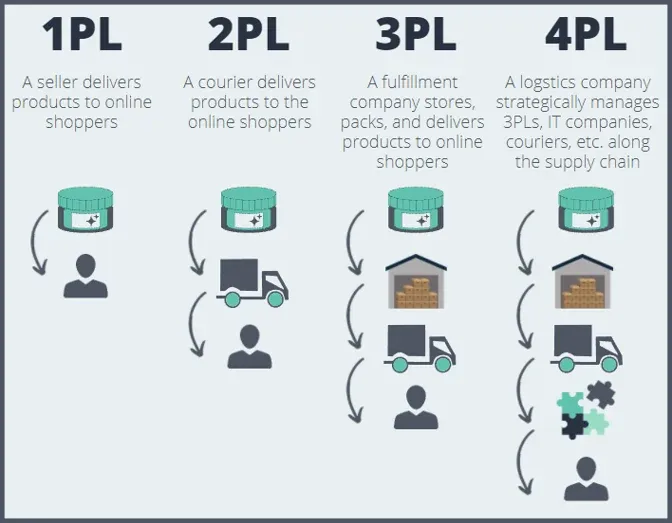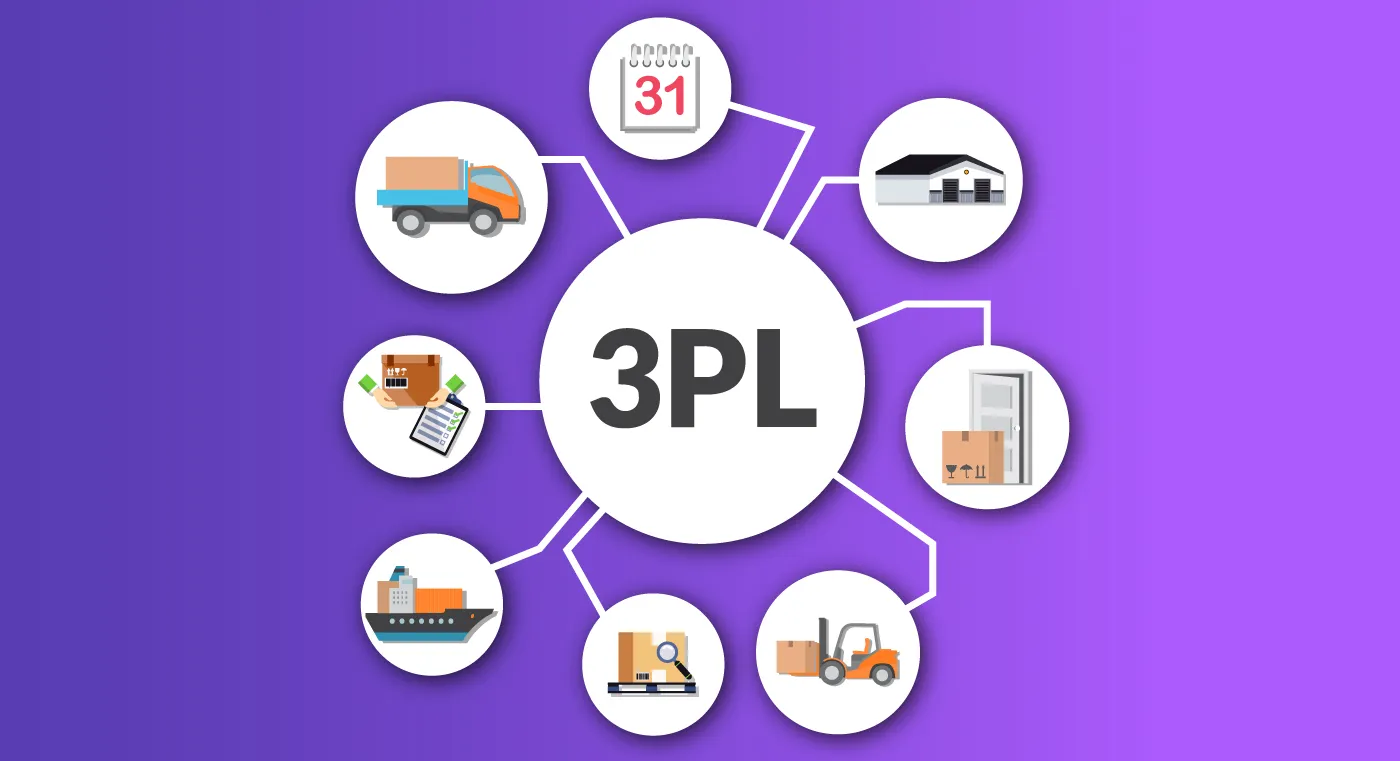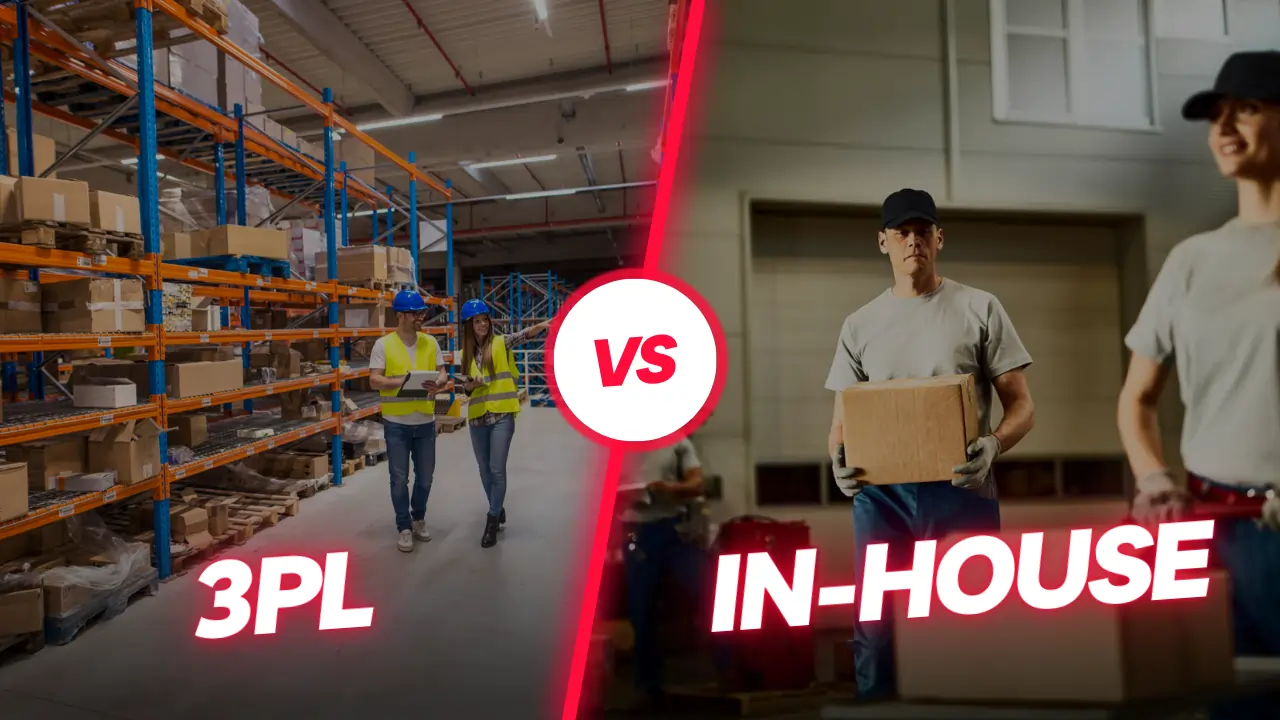Third-Party Logistics (3PL): Benefits and Challenges Explained
.webp)
Third party logistics, or 3PL as it is commonly referred to, is the outsourcing of the fulfillment of orders to an external party. A 3PL service provider will handle the receiving of products, the fulfillment and shipping of orders with those products, and any returns of those orders on your behalf.
Why is Third-Party Logistics (3PL)?
Third-party logistics (3PL) is a service where businesses outsource their supply chain and logistics operations to specialized providers, known as 3PL companies.
These logistics providers handle critical tasks such as inventory management, warehousing, order fulfillment, and shipping. By leveraging the expertise and infrastructure of a 3PL warehouse, companies can streamline their supply chain, reduce costs, and improve customer satisfaction.
To understand 3PL in context, let’s compare it to other logistics models:
- 1PL (First-Party Logistics): Where the seller handles every aspect of logistics internally. For example, a local farmer who grows produce and delivers it directly to customers or stores without outsourcing any part of the supply chain is an example of 1PL.
- 2PL (Second-Party Logistics): A transportation-focused model where carriers or shippers manage the delivery of goods from warehouses to customers.
- 3PL (Third-Party Logistics): Providers store, pick, pack, and ship goods on behalf of the business, integrating various aspects of supply chain management.
- 4PL (Fourth-Party Logistics): A more comprehensive approach where a logistics provider oversees and manages multiple 3PL companies, offering end-to-end supply chain solutions.

Growth of the 3PL Industry
The 3PL industry has seen tremendous growth in recent years, driven by the rise of eCommerce and the need for efficient supply chain solutions.
- The global 3PL market was valued at over $1 trillion in 2023 and is projected to grow to nearly $2 trillion by 2030, with a CAGR of approximately 8.5%.
- Over 90% of Fortune 500 companies utilize third-party logistics providers to optimize their supply chain operations.
- Advanced logistics services, such as AI-powered inventory management and real-time tracking, have made 3PL providers indispensable to businesses across various industries.
Real-World Applications of 3PL
- E-commerce: Online retailers rely on 3PL warehouses to store inventory, manage order fulfillment, and ensure fast shipping to customers globally. For example, a fashion brand may use a 3PL to handle returns (reverse logistics) and custom packaging. For insights into the future of e-commerce trends that may influence 3PL strategies, explore this article here.
- Retail: Brick-and-mortar stores partner with 3PL companies for warehousing and distribution, ensuring shelves are stocked and inventory is replenished efficiently.
- Manufacturing: Manufacturers work with 3PL providers to transport raw materials and distribute finished goods to retailers, optimizing their supply chain and reducing costs.
By outsourcing logistics to 3PL providers, businesses across industries can focus on growth while ensuring reliable and efficient supply chain operations.
How does a 3PL work?

A 3PL service provider manages various aspects of the supply chain, from receiving inventory to delivering orders to customers. While specific services may vary between 3PL companies, here’s a breakdown of the core logistics processes:
- Receiving: The 3PL warehouse receives inventory from manufacturers or suppliers. The logistics provider counts, scans, and organizes products by barcode or SKU for accurate inventory management.
- Storing: Products are stored in warehouse space designed for easy access during fulfillment. Efficient warehouse management ensures goods are readily available for picking.
- Picking: When an order is placed, the 3PL system notifies workers to retrieve the required items. Using optimized picking lists, staff collect items for multiple orders simultaneously to streamline operations.
- Packing: Retrieved items are scanned, grouped, and packed appropriately. The 3PL provider adds shipping labels, receipts, and custom packaging, if requested, preparing the order for delivery.
- Shipping: The packed order is handed over to shipping carriers for final delivery to customers. Tracking information is uploaded to the 3PL’s system and synced with the seller’s software for real-time updates.
- Returns (Reverse Logistics): Some 3PL companies handle returns, inspecting products, restocking sellable items, and disposing of unsellable goods. Reverse logistics adds complexity, making it a specialized service, not all providers offer.
This process allows businesses to focus on product development and marketing while leaving logistical operations to experienced providers. By partnering with a 3PL, companies can reduce costs, scale efficiently, and deliver exceptional service to their customers.
How Do 3PLs Make Money?
Third-party logistic providers have a fairly complex pricing structure, which will vary from provider to provider. The most common is charging a fee for each step of the fulfillment process:
- Receiving fee - a charge per unit received at the 3PL facility
- Storage fee - for any products kept in inventory with the 3PL facility, usually calculated based on the last day of the month. Think of it as a fee for the space your products take up in a 3PL warehouse.
- Pick and packing fees - 3PL will charge for the fulfillment of orders. Typically, they have a fee for the first product of an order and then a lower fee for any additional items in the same order. An order with multiple items will have a higher total fee but a lower average fee per item.
- Other fees - these are fees for special projects that a 3PL provider might do for you, return fees, customer service, etc.
Why Use a 3PL? Benefits of Third-Party Logistics

Having a 3PL provider offers several advantages to companies by outsourcing order fulfillment logistics. The main benefits are:
- Expertise - You can rely on the expert knowledge of logistics professionals whose primary focus day in and day out is finding the best solution to optimize your order fulfillment and increase the speed at which your customers receive their products and orders.
- Lower costs - Depending on the volume and the fluctuation of orders, outsourcing the complexity of order fulfillment to a 3PL service provider provides a lower-cost solution than having it in-house. With a 3PL, you only incur costs as you use their services versus having the fixed costs of staffing, warehouse space, and equipment when running order fulfillment in-house.
- Scalability - 3PLs give you scalable resources to meet your needs as your business scales and can quickly adapt to seasonal fluctuations in your business. This helps keep your focus where it matters: with your product and business.
How to Choose the Right 3PL Service Provider: 7 Steps
Selecting the right third-party logistics (3PL) provider is a critical decision that can greatly impact your supply chain efficiency, customer satisfaction, and overall business growth. To ensure you choose a provider that aligns with your needs, consider the following steps:
Step 1: Assess Geographic Coverage
Begin by evaluating the 3PL’s network of warehouses and distribution centers.
A provider with facilities strategically located near your target markets can significantly reduce shipping times and costs.
If you plan to expand internationally, prioritize a provider with a strong global presence and expertise in navigating customs, tariffs, and international freight logistics.
This alignment with your business's shipping goals, whether local, regional, or global, is essential for ensuring smooth operations.
Step 2: Analyze Cost Structures
Carefully review the provider's cost structures and request a transparent breakdown of all fees, including storage, picking and packing, shipping, and additional service charges.
Be mindful of hidden costs, such as fees for reverse logistics, custom packaging, or peak season surcharges.
Comparing cost structures across multiple 3PL companies will help you identify a partner that offers the best balance between affordability and service quality.
Step 3: Consider Industry Specialization
Choose a logistics provider with proven expertise in your specific industry.
For example, eCommerce businesses should look for providers adept at handling fast-moving inventory, real-time order tracking, and efficient last-mile delivery.
Retail businesses benefit from providers experienced in large-scale distribution and consistent restocking.
Similarly, manufacturers require a 3PL with a deep understanding of B2B supply chains, raw material management, and freight shipments. Industry-specific knowledge ensures the provider is equipped to address your unique challenges.
Step 4 Evaluate Value-Added Services
A 3PL should offer more than just basic warehousing and shipping services.
Seek providers that deliver additional capabilities, such as custom packaging to enhance your brand’s unboxing experience and reverse logistics to handle returns efficiently.
Providers that offer technology integration, including advanced inventory management software and real-time tracking, can streamline operations.
Additionally, international shipping expertise is invaluable for businesses targeting global markets, as it ensures smooth cross-border logistics and compliance with customs regulations.
Step 5: Check Scalability and Flexibility
Ensure the 3PL provider can scale with your business as it grows.
This includes their capacity to handle increased inventory levels, seasonal demand fluctuations, and potential international expansion.
Flexibility to adapt to changing supply chain strategies or accommodate special requests is equally important for maintaining a strong partnership as your business evolves.
Step 6: Assess Customer Support
Choose a logistics provider known for responsive and proactive customer support.
Providers that offer a dedicated account manager or support team can quickly address and resolve any operational challenges.
It is helpful to review testimonials and case studies to gauge their reliability and reputation for excellent service.
Step 7: Test Compatibility
Before committing to a long-term partnership, conduct a trial run or pilot program to test how well the 3PL integrates with your operations.
This allows you to identify potential challenges and ensure their systems align with your workflow, such as inventory tracking and reporting.
A trial period also gives you insight into how effectively the provider communicates and adapts to your needs.
By following these steps, you can confidently select a 3PL provider that meets your business requirements, enhances your supply chain processes, and supports your long-term growth objectives.
Limitations of Using a 3PL
Outsourcing order fulfillment to 3PL companies offers numerous advantages but also presents certain challenges.
When relying on a 3PL warehouse for critical aspects of supply chain management, businesses often face limitations such as reduced direct oversight of inventory management, logistical operations, and customer service. This can lead to quality control issues and potential delays in shipments or delivery.
Here are some major limitations you can face using a 3PL company:
- Lack of Direct Control: Working with logistics providers means entrusting them with your warehousing, transportation, and fulfillment services. This limits your ability to directly monitor and manage operations, potentially affecting efficiency and customer satisfaction.
- Customization Challenges: Some logistics companies operate on standardized processes, which can restrict your ability to optimize packaging, branding, or reverse logistics to suit unique business needs.
- Increased Dependency: Shippers and businesses become dependent on their logistics partner to maintain inventory accuracy, warehouse management, and seamless supply chain operations. Any disruption in the 3PL provider’s system can have a ripple effect on your business.
Despite these limitations, businesses can streamline their supply chain by fostering clear communication and setting performance benchmarks with their 3PL provider. This approach can help optimize fulfillment and ensure the 3PL partnership is an asset rather than a liability.
3PL vs. In-House Fulfillment

In-house fulfillment is a logistics strategy where a business manages all aspects of its order fulfillment process internally without outsourcing to third-party providers.
This includes tasks such as inventory management, warehousing, packing, and shipping products directly to customers.
Choosing between outsourcing logistics to a 3PL company or managing fulfillment in-house is a critical decision that impacts your supply chain, operational efficiency, and customer experience. Here’s how the two compare:
3PL (Third-Party Logistics)
Pros:
- Scalability and Flexibility: A 3PL provider can scale its services, such as warehousing and transportation, to handle seasonal fluctuations or increased demand.
- Cost Efficiency: By leveraging shared resources like storage and shipping networks, 3PL companies can reduce costs for businesses compared to maintaining in-house operations.
- Expertise in Logistics Services: Third-party logistics providers specialize in areas like inventory management, freight handling, and supply chain optimization, ensuring smooth and timely distribution.
- Time Savings: Outsourcing logistics allows businesses to focus on growth strategies rather than day-to-day operations.
Cons:
- Loss of Oversight: Shippers who rely on 3PL warehouses have less control over logistics management, leading to potential quality and delivery issues.
- Additional Fees: Logistics companies may charge for services like managed inventory, returns processing, or contract adjustments, increasing overall costs.
- Communication Gaps: Misalignment between the business and the 3PL provider can result in errors that affect customer satisfaction.
In-House Fulfillment
Pros:
- Complete Control: Businesses retain full oversight of their supply chain, from warehousing to shipping, ensuring greater attention to detail.
- Brand Customization: In-house operations allow for personalized packaging, delivery, and customer interactions, strengthening brand loyalty.
- Customer Service: Handling logistics internally enables quicker responses to issues like returns or damaged shipments.
Cons:
- High Costs: Operating a warehouse, hiring staff, and managing transportation requires significant upfront and ongoing investment.
- Limited Scalability: In-house fulfillment may struggle to scale as order volumes grow, especially without advanced logistics systems in place.
- Time-Intensive: Managing supply chain logistics in-house can divert resources from other critical business areas.
By weighing the pros and cons of third-party logistics versus in-house fulfillment, businesses can choose the strategy that aligns with their growth objectives, budget, and customer needs.
Get Started with Fourthwall's 3PL Fulfillment!

Ready to take your business to the next level?
Fourthwall’s 3PL fulfillment services make it easy to manage products you’ve sourced or created yourself—offering seamless inventory storage, preparation, and shipping support.
Whether you’re selling custom designs or unique items not in our catalog, Fourthwall’s partnership with warehouses in California and Kentucky ensures your goods are delivered efficiently and professionally.
With straightforward pricing, detailed shipping guidelines, and expert support every step of the way, you’ll have the tools to keep your customers happy and streamline your operations.
Get started today, and let Fourthwall handle the logistics so you can focus on creating!
Frequently Asked Questions
What Is a 4PL?
A 4PL (fourth-party logistics) provider is a supply chain management partner that oversees and coordinates the entire logistics process, acting as a single point of contact for businesses.
Unlike 3PL logistics companies, which focus on specific tasks like warehousing, shipping, or inventory management, 4PL providers manage multiple 3PLs, shippers, carriers, and transportation services to deliver comprehensive logistical solutions.
They handle everything from freight coordination and LTL (less-than-truckload) shipments to storage and distribution, optimizing the supply chain for maximum efficiency.
By outsourcing logistics to a 4PL, businesses can streamline complex operations, reduce costs, and focus on core activities while ensuring smooth delivery and managed inventory across their networks.
What Are 3PLs in the Supply Chain?
Acting as critical partners in the supply chain, 3PLs handle tasks such as shipments and distribution and work with carriers to ensure efficient delivery.
They provide logistical solutions to help businesses manage inventory, optimize transportation, and streamline operations, allowing companies to focus on their core activities.
Unlike 4PL providers, which oversee and coordinate multiple logistics services and partners, 3PLs focus on specific aspects of the supply chain, such as warehousing, trucking, and last-mile delivery.
What Are 3PLs and 4PLs?
3PLs (third-party logistics) and 4PLs (fourth-party logistics) are key players in supply chain management, offering businesses varying levels of logistical support.
3PLs are logistics companies that handle specific services such as warehousing, inventory management, freight transportation, and order fulfillment, allowing businesses to streamline operations and focus on core activities.
In contrast, 4PLs act as strategic partners that manage and coordinate the entire supply chain, overseeing multiple 3PLs, carriers, and transportation services to provide an end-to-end logistical solution.
While 3PLs focus on operational tasks like storage and shipments, 4PLs deliver comprehensive supply chain management, offering businesses a single point of contact for optimizing efficiency across all logistics services.
















